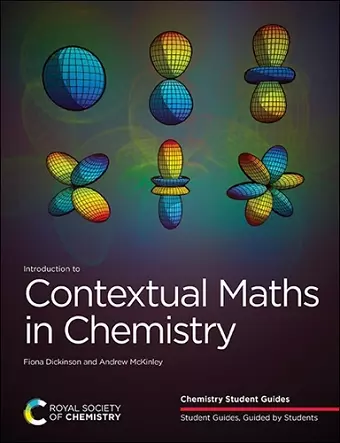Introduction to Contextual Maths in Chemistry
Fiona Dickinson author Andrew McKinley author
Format:Paperback
Publisher:Royal Society of Chemistry
Published:23rd Oct '20
Currently unavailable, our supplier has not provided us a restock date

CHEMISTRY STUDENT GUIDES. GUIDED BY STUDENTS For any student who has ever struggled with a mathematical understanding of chemistry, this book is for you. Mathematics is the essential tool for physical scientists. We know that confidence in using mathematics early on in a chemistry degree builds a solid foundation for further study. However, applying the abstract mathematics taught in schools to chemical phenomena is one of the biggest challenges that chemistry students face. In this book, we take a 'chemistry-first' approach. We link the mathematics to recognisable chemical concepts, building on high school chemistry, to facilitate deeper understanding. We cover the practical mathematical skills, including representation of data as tables and graphs, and give an overview of error handling in the physical sciences. More advanced mathematical concepts are introduced, using calculus to determine kinetic rate laws, intermolecular forces and in quantifying energetic change in thermodynamics. We also introduce the concept of the complex number and its role in considering quantum wave functions, widely used in computational chemistry. There are worked examples and problem sets to provide plenty of practise material to build proficiency. We also include insights from real students, which identify common problem areas and provide the prompts that helped them to overcome these. Chemistry Student Guides are written with current students involved at every stage, guiding the books towards the most challenging aspects of the topic.
The teaching of mathematics to students of chemistry has always been a difficult undertaking. Many students do not appreciate the value of mathematics in their subject and their confidence is often further undermined by textbooks which rely heavily on examples drawn from physics. Dickinson & McKinley bring a great deal of experience of chemistry teaching at degree level and their textbook is explicitly organised so that mathematical concepts are mapped directly to topics a chemistry student will find familiar. The book also places emphasis on techniques of dimensional analysis and the statistical analysis of data, which are often poorly taught to chemistry students. Overall the book fills a gap in chemical education and is highly recommended to anyone teaching physical chemistry or laboratory skills to chemistry students in higher education.
* University of Newcastle *The book covers a wide range of topics, giving rounded support for the maths required for a chemistry degree. It is broken down well into manageable chunks with context laced throughout which help to add depth to the concepts being learned or revised. This is useful for people, such as myself, who learn better by applying concepts to ‘the bigger picture’. The breakdown of the vocabulary is also really useful, as lecturers often don’t realise that they’re introducing a new concept, or explain it very briefly, so having a source to consolidate that and ensure I’ve understood their explanation is very helpful. The increased complexity of the equations I was dealing with compared to A -Level drove consideration of units from my mind, but the way this book breaks down the section on units and gives examples would probably save me from losing easy marks in an exam.
* Student - University of Bath *I found that the book teaches Maths in a way that is easily digestible to a student. There are no "big words" or fancy Maths terminology meaning that if you haven’t seen a certain concept before, it’s easy to understand what is being taught. I would definitely recommend this book to any student, whether you have studied maths previously or not, as it teaches the fundamental concepts which are used within a Chemistry degree.
* Student - University of BaISBN: 9781788014250
Dimensions: unknown
Weight: unknown
295 pages